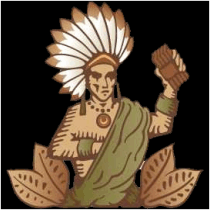| Cigar Useful Informations |
History of cigars
The first modern observation of the cigar occurred with the
arrival of Christopher Columbus in the New World. On October
28, 1492, Columbus noted in his log reports that the natives of
San Salvador burned and inhaled the leaves of a local plant.
Rodrigo de Xeres, a lieutenant on Columbus's expedition
became the first European to smoke the Indian's form of a
cigar. Rodrigo smoked on every subsequent day of the
expedition. The Indians in South and Central America did not
smoke cigars as we know them today. The natives smoked
tobacco wrapped in maize, palm or other native vegetation.
arrival of Christopher Columbus in the New World. On October
28, 1492, Columbus noted in his log reports that the natives of
San Salvador burned and inhaled the leaves of a local plant.
Rodrigo de Xeres, a lieutenant on Columbus's expedition
became the first European to smoke the Indian's form of a
cigar. Rodrigo smoked on every subsequent day of the
expedition. The Indians in South and Central America did not
smoke cigars as we know them today. The natives smoked
tobacco wrapped in maize, palm or other native vegetation.

How to cut a Cigar
The first step involved in preparing a cigar for use is to open a
passage way allowing air to circulate from one end to the other.
Some smokers elect to bite the tip off the cigar; its quick and
easy solution and there is no need to carry around any tools
along. Most cigar connoisseurs however use specialized
clipper that provide a clean, manicured cut. If a cutter is used,
the incision should be made quickly and decisively. The cutter
should be placed just above the cigar's cap line and clipped in
one swift motion. This produces a clean cut which is desirable
for smoking a cigar. Once the cigar has been clipped using the
smokers preferred cigar has been clipped using the smokers
preferred straight slice across the cigars cap line. It is the best
method, it is ready to be lit. Types of cutters. The cut to create an
easy, well circulated draw; however residue and tar from the
burning tobacco will come in direct contact with the smoker's
mouth. The "Bullet" or "Punch" Cut A bullet cutter pierces a
small hole into the cigars cap. Depending on the diameter of
the cutter, air circulation may be restricted and the smokes tar
and residue can accumulate around the opening. The "V" Cut
The V cutter creates a wedge shaped notice in the cigars cap.
This cut allows proper air circulation to occur. The smokes tar
and residue accumulate on the sides of the wedge keeping the
bitter taste away from the smoker's mouth. It can be difficult to
keep a V cutter sharp because of its unique shape.
passage way allowing air to circulate from one end to the other.
Some smokers elect to bite the tip off the cigar; its quick and
easy solution and there is no need to carry around any tools
along. Most cigar connoisseurs however use specialized
clipper that provide a clean, manicured cut. If a cutter is used,
the incision should be made quickly and decisively. The cutter
should be placed just above the cigar's cap line and clipped in
one swift motion. This produces a clean cut which is desirable
for smoking a cigar. Once the cigar has been clipped using the
smokers preferred cigar has been clipped using the smokers
preferred straight slice across the cigars cap line. It is the best
method, it is ready to be lit. Types of cutters. The cut to create an
easy, well circulated draw; however residue and tar from the
burning tobacco will come in direct contact with the smoker's
mouth. The "Bullet" or "Punch" Cut A bullet cutter pierces a
small hole into the cigars cap. Depending on the diameter of
the cutter, air circulation may be restricted and the smokes tar
and residue can accumulate around the opening. The "V" Cut
The V cutter creates a wedge shaped notice in the cigars cap.
This cut allows proper air circulation to occur. The smokes tar
and residue accumulate on the sides of the wedge keeping the
bitter taste away from the smoker's mouth. It can be difficult to
keep a V cutter sharp because of its unique shape.
Origin of the word "Cigar"
The Spanish created the cigar industry, and are given credit for
creating the modern cigar. The Origin of the word cigar comes
from the native language of the "Ciq-Sigan" which the Spanish
word "Cigarro" is derived from. The New English Dictionary of
1735 called the cigar a "seegar", and was later adapted into the
modern word "cigar".
creating the modern cigar. The Origin of the word cigar comes
from the native language of the "Ciq-Sigan" which the Spanish
word "Cigarro" is derived from. The New English Dictionary of
1735 called the cigar a "seegar", and was later adapted into the
modern word "cigar".

The ancient Mayans
Christopher Columbus
Tobacco Cultivation
Cigar seeds are selected for growing. It takes approximately six
weeks to germinate seeds before transplanting to a field; six
weeks to grow the tobacco plant to maturity; six weeks for a
complete harvest, followed by a series of periods of
fermentation. In the fermentation stage, workers pile slightly
moistened tobacco in huge bales or stacks; temperatures
inside the bales reach as high as 140¡ as the cigar "sweats"
during the early stages of the fermentation. Some tobacco may
be "turned" up to three of four times and re-moistened before
fermentation finally ceases. The process releases ammonia
from the tobacco affecting wrapped in bales, usually
surrounded by burlap, to age. Standard aging time is 18
months to two years, although some manufacturers keep
inventories of tobacco as old as 10 years. Prior to releasing the
bales to the rollers for manufacturing, the bales are moistened
again to make the leaves supple.
weeks to germinate seeds before transplanting to a field; six
weeks to grow the tobacco plant to maturity; six weeks for a
complete harvest, followed by a series of periods of
fermentation. In the fermentation stage, workers pile slightly
moistened tobacco in huge bales or stacks; temperatures
inside the bales reach as high as 140¡ as the cigar "sweats"
during the early stages of the fermentation. Some tobacco may
be "turned" up to three of four times and re-moistened before
fermentation finally ceases. The process releases ammonia
from the tobacco affecting wrapped in bales, usually
surrounded by burlap, to age. Standard aging time is 18
months to two years, although some manufacturers keep
inventories of tobacco as old as 10 years. Prior to releasing the
bales to the rollers for manufacturing, the bales are moistened
again to make the leaves supple.





Tobacco Seeds
Tobacco Plants
Fermited Tobacco Leaves
Tobacco Bales Stacks
Aged Tobacco Bales
Manufacturing Process of the Cigar
The tobacco that is rolled into cigars is primarily grown Canary
Islands, Connecticut, Cuba, the Dominican Republic, Ecuador,
Nicaragua, and Sumatra are world renown in growing the
quality tobacco that is used in The tobacco that is rolled into
cigars is primarily grown the various components of a cigar.
Tobacco is planted in the tropical regions of the world. Africa,
Brazil, the in late September and generally takes two months to
reach maturity. Harvesting begins before the plants flower and
can take several months as the leaves are harvested in
different phases. Once the tobacco is harvested the leaves are
sent to "tobacco barns" where the tobacco is dried. Leaves are
tied in pairs and hung for the curing process. The tobacco barn
faces from west so that the sun hits one side in the morning
and one side at night. The doors at either side can be opened
or closed to keep the temperature constant. The tobacco is kept
in the barn for approximately 2 months while the leaves change
color from green to yellow to brown. After the leaves are dried,
they are carefully laid into large piles for fermentation, where
they are kept for several months. The piles are moistened and
covered in cloth and are watched closely as the temperature
can rise and harm the tobacco. The fermentation reduces
natural resins, ammonia and nicotine present in the tobacco
leaves. The fermented tobacco is taken to warehouses, stored
in large bales and allowed to slowly mature. The aging process
can last from several months to many years depending on the
quality desired. Once the aged tobacco reaches the factory, the
leaves are graded according to size, color, and quality. Leaves
that are torn or have holes are set aside and used primarily as
filler. Finally the leaves are de-veined by removing the center
vein from the leaf. There are three basic components that make
up a cigar. The filler - The binder - The wrapper. Handmade
cigars are composed of filler tobacco bunched together with a
binder leave and finally covered with the wrapper leaf. Cigars
with long leaves bunched together as filler are called "long
filler" cigars. Cigars with short, fragmented leaves bunched
together as filler are called "short filler" cigars. The binder holds
the bunch together and is enclosed with the wrapper leaf in an
aesthetically pleasing manner.
Islands, Connecticut, Cuba, the Dominican Republic, Ecuador,
Nicaragua, and Sumatra are world renown in growing the
quality tobacco that is used in The tobacco that is rolled into
cigars is primarily grown the various components of a cigar.
Tobacco is planted in the tropical regions of the world. Africa,
Brazil, the in late September and generally takes two months to
reach maturity. Harvesting begins before the plants flower and
can take several months as the leaves are harvested in
different phases. Once the tobacco is harvested the leaves are
sent to "tobacco barns" where the tobacco is dried. Leaves are
tied in pairs and hung for the curing process. The tobacco barn
faces from west so that the sun hits one side in the morning
and one side at night. The doors at either side can be opened
or closed to keep the temperature constant. The tobacco is kept
in the barn for approximately 2 months while the leaves change
color from green to yellow to brown. After the leaves are dried,
they are carefully laid into large piles for fermentation, where
they are kept for several months. The piles are moistened and
covered in cloth and are watched closely as the temperature
can rise and harm the tobacco. The fermentation reduces
natural resins, ammonia and nicotine present in the tobacco
leaves. The fermented tobacco is taken to warehouses, stored
in large bales and allowed to slowly mature. The aging process
can last from several months to many years depending on the
quality desired. Once the aged tobacco reaches the factory, the
leaves are graded according to size, color, and quality. Leaves
that are torn or have holes are set aside and used primarily as
filler. Finally the leaves are de-veined by removing the center
vein from the leaf. There are three basic components that make
up a cigar. The filler - The binder - The wrapper. Handmade
cigars are composed of filler tobacco bunched together with a
binder leave and finally covered with the wrapper leaf. Cigars
with long leaves bunched together as filler are called "long
filler" cigars. Cigars with short, fragmented leaves bunched
together as filler are called "short filler" cigars. The binder holds
the bunch together and is enclosed with the wrapper leaf in an
aesthetically pleasing manner.
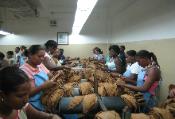
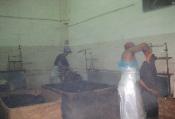
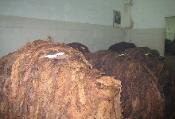
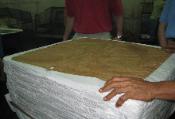
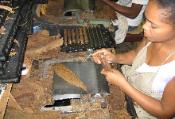
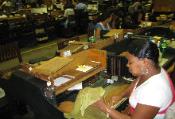
Curing Process of the Tobacco
| Moistured Tobacco Piles |
| Tobacco Grading Process |
| Tobacco Large Bales to Age |
| Binder & Filler are combined |
| Making the Cigar |
Choosing a Cigar
Choosing: Each country's cigar production has its own taste
and character. Cigars are made all over the world, with tobacco
grown in different soils, cured by different processes, and rolled
with different techniques, each element contributing to the taste
and flavor of individual brands and types. These are not hard
and fast rules, but you'll have something to go by when you're
faced with a humidor full of cigars from which to choose.
-- Cigars from Jamaica are usually considered mild.
-- Cigars from the Dominican Republic are mild to medium in
strength.
-- Cigars from Honduras and Nicaragua are stronger and
heavier smokes.
-- And cigars from Cuba are considered to be some of the
richest and creamiest in the world!
and character. Cigars are made all over the world, with tobacco
grown in different soils, cured by different processes, and rolled
with different techniques, each element contributing to the taste
and flavor of individual brands and types. These are not hard
and fast rules, but you'll have something to go by when you're
faced with a humidor full of cigars from which to choose.
-- Cigars from Jamaica are usually considered mild.
-- Cigars from the Dominican Republic are mild to medium in
strength.
-- Cigars from Honduras and Nicaragua are stronger and
heavier smokes.
-- And cigars from Cuba are considered to be some of the
richest and creamiest in the world!

How to judge a cigar "The 3 C's"
Construction - How well is the cigar made? How does it feel to
the touch? With a firm, but soft grip feel it from end to end. Does
it feel consistent all the way through? Are there any hard or soft
spots? A cigar that is too hard, too soft, or inconsistent will not
draw properly. Condition - Cigars should be well conditioned
before smoking. Cigars should be aged for several months to
several years at the proper humidity (70% RH) and temperature
(70° F). A dry cigar will burn hot, fast and can taste harsh. A
damp cigar will be hard to light and can be hard to draw.
Causality (cause and effect) - How does the cigar taste? How
does the cigar make you feel? Does the cigar build in taste,
flavor and complexity as it burns? Or is it the same all the way
through? Do you feel relaxed and calm after finishing it?
Machine made cigars are generally produced using short filler.
A processed tobacco binder which resembles brown paper is
used as the binder, and in most cases a natural wrapper is
used to complete the cigar.
the touch? With a firm, but soft grip feel it from end to end. Does
it feel consistent all the way through? Are there any hard or soft
spots? A cigar that is too hard, too soft, or inconsistent will not
draw properly. Condition - Cigars should be well conditioned
before smoking. Cigars should be aged for several months to
several years at the proper humidity (70% RH) and temperature
(70° F). A dry cigar will burn hot, fast and can taste harsh. A
damp cigar will be hard to light and can be hard to draw.
Causality (cause and effect) - How does the cigar taste? How
does the cigar make you feel? Does the cigar build in taste,
flavor and complexity as it burns? Or is it the same all the way
through? Do you feel relaxed and calm after finishing it?
Machine made cigars are generally produced using short filler.
A processed tobacco binder which resembles brown paper is
used as the binder, and in most cases a natural wrapper is
used to complete the cigar.
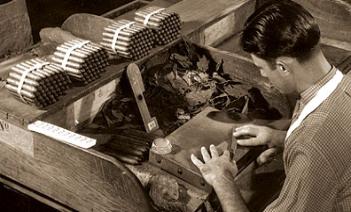
| Final Process of Cigar Making |

Cigar taste & flavor
Each country's cigar production has its own taste and character.
Cigars are made all over the world, with tobacco grown in
different soils, cured by different processes, and rolled with
different techniques, each element contributing to the taste and
flavor of individual brands and types. One of the biggest
challenges facing cigar manufacturers is providing consistency
in their blends; a feat almost impossible given all the variables
that contribute to a finished product. The only agreements
among makers seem to be that a wrapper has the greatest
potential impact on overtones and undertones of taste, and filler
(the heart of the cigar) determines overall strength or weakness
(or fullness of body). As no two cigars taste exactly the same,
adding a stronger tobacco one year and a weaker one the next
to achieve the same balance creates the illusion of
consistency; no such thing ever really exists. Generally
speaking, a binder, even one of relatively weak tobacco, will
have some impact on the quality of the smoke, while the filler
will determine overall strength; the wrapper will add a great
deal of character, or not much at all, depending upon its
condition, seed origin and type. The aging process also
contributes to taste and flavor although the impact on overall
quality is considered less important. Although the aging
process changes the taste of tobacco, it doesn't affect its
quality; in some countries, people smoke and enjoy younger
tobaccos. Conversely, the manufacturing process can have a
dramatic effect on the taste, flavor and quality of a finished cigar.
Here is where a beautifully made cigar of a modest blend can
compare favorably or better than a fine blend used in an
improperly made cigar. While the experts may differ in their
opinions of which element cause what effect, they all seem to
agree on this. Taste is not acquired because we know the
chemical analysis of the tobacco. Its the romance in the
encounter that makes a great cigar. Knowing some basics will
add to experience. And yes, sometimes a cigar is just a cigar.
Cigars are made all over the world, with tobacco grown in
different soils, cured by different processes, and rolled with
different techniques, each element contributing to the taste and
flavor of individual brands and types. One of the biggest
challenges facing cigar manufacturers is providing consistency
in their blends; a feat almost impossible given all the variables
that contribute to a finished product. The only agreements
among makers seem to be that a wrapper has the greatest
potential impact on overtones and undertones of taste, and filler
(the heart of the cigar) determines overall strength or weakness
(or fullness of body). As no two cigars taste exactly the same,
adding a stronger tobacco one year and a weaker one the next
to achieve the same balance creates the illusion of
consistency; no such thing ever really exists. Generally
speaking, a binder, even one of relatively weak tobacco, will
have some impact on the quality of the smoke, while the filler
will determine overall strength; the wrapper will add a great
deal of character, or not much at all, depending upon its
condition, seed origin and type. The aging process also
contributes to taste and flavor although the impact on overall
quality is considered less important. Although the aging
process changes the taste of tobacco, it doesn't affect its
quality; in some countries, people smoke and enjoy younger
tobaccos. Conversely, the manufacturing process can have a
dramatic effect on the taste, flavor and quality of a finished cigar.
Here is where a beautifully made cigar of a modest blend can
compare favorably or better than a fine blend used in an
improperly made cigar. While the experts may differ in their
opinions of which element cause what effect, they all seem to
agree on this. Taste is not acquired because we know the
chemical analysis of the tobacco. Its the romance in the
encounter that makes a great cigar. Knowing some basics will
add to experience. And yes, sometimes a cigar is just a cigar.
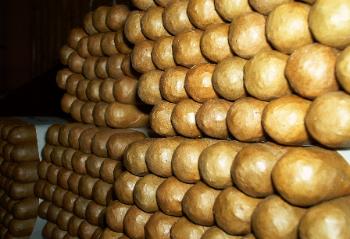
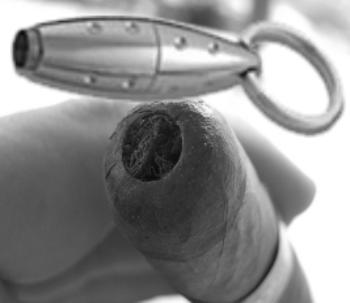
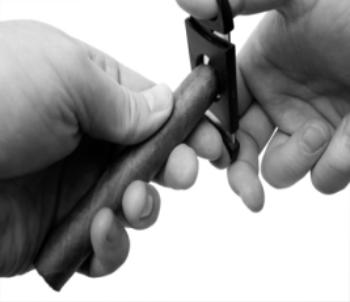
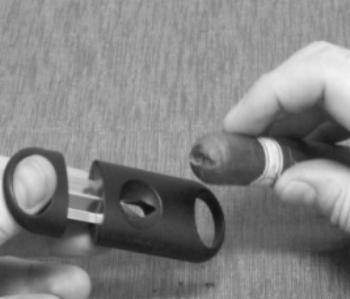
Punch or Bullet Cut
Straight Cut
V- Cut
How to light a Cigar
Tobacco will absorb any aroma or fragrance that it comes in
contact with. Paper and sulfur based matches or the use of a
fluid based lighter can leave the cigar with an unpleasant taste.
The preferred method to light a cigar is the use of a butane
based lighter. A lit wooden match can be used once it has
burned off the chemicals used in the ignition process. Once the
cigar is cut, hold the open end of the cigar over your flame and
slowly rotate it. This will "Toast" the cigar and prime it for
lighting. While it is still warm, place the cigar in your mouth and
hold it at a 45° angle over the flame. Slowly puff and rotate the
cigar while maintaining slight contact with the flame. A Good
cigar will light easy and burn evenly.
contact with. Paper and sulfur based matches or the use of a
fluid based lighter can leave the cigar with an unpleasant taste.
The preferred method to light a cigar is the use of a butane
based lighter. A lit wooden match can be used once it has
burned off the chemicals used in the ignition process. Once the
cigar is cut, hold the open end of the cigar over your flame and
slowly rotate it. This will "Toast" the cigar and prime it for
lighting. While it is still warm, place the cigar in your mouth and
hold it at a 45° angle over the flame. Slowly puff and rotate the
cigar while maintaining slight contact with the flame. A Good
cigar will light easy and burn evenly.

Lighting a cigar with butane based lighter
How to store a Cigar
Cigars should be kept in a controlled environment. A cedar
lined box, called a humidor is traditionally used for storage. The
cedar helps flavor and age the cigar. Cedar also holds
moisture well which helps keep humidity at a constant level.
Cigars kept at 70% RH and 70° F offer the best smoking
experience. Tobacco burns smoothly and tastes the best when
kept with in this range. A dry cigar burns fast and has a harsh
flavor. A damp cigar will be hard to keep lit and can grow mold
while in storage. Humidors should always close tightly,
providing a seal that keeps the atmosphere inside at a constant
level. A reusable moisturizer should be used to aid in the
humidification. A gauge that monitors temperature and humidity
can be helpful to keep optimal conditions constant.
lined box, called a humidor is traditionally used for storage. The
cedar helps flavor and age the cigar. Cedar also holds
moisture well which helps keep humidity at a constant level.
Cigars kept at 70% RH and 70° F offer the best smoking
experience. Tobacco burns smoothly and tastes the best when
kept with in this range. A dry cigar burns fast and has a harsh
flavor. A damp cigar will be hard to keep lit and can grow mold
while in storage. Humidors should always close tightly,
providing a seal that keeps the atmosphere inside at a constant
level. A reusable moisturizer should be used to aid in the
humidification. A gauge that monitors temperature and humidity
can be helpful to keep optimal conditions constant.

Perfect Method to store your cigars
Drinks that compliment Cigars
Like love and marriage, spirits and wine go together with cigars
like the proverbial horse and carriage. Your choice of beverage
depends on personal taste, and it can vary according to the
occasion. Here are some popular favorites. You pick the time
and place. The Martini: Have it any way you want, this is a
classic partnering. Bourbon/Scotch: In the world of spirits, small
batch and single barrel Bourbons and single malt Scotches are
super premium products that have the complexity and depth of
flavor to stand up to a cigar. Port: Port is a traditional partner for
a great cigar. The sweetness and alcoholic power of vintage
port blends perfectly with a full-bodied smoke; even younger
vintage ports are appropriate because their strong tannins
stand up to a spicy smoke. Cognac: The most popular
traditional drink with fine cigars is cognac or brandy. Wine:
Complementary wines include Cabernet Sauvignon and
Rh™ne varieties such as Syrah, Grenache and Mourvedre.
like the proverbial horse and carriage. Your choice of beverage
depends on personal taste, and it can vary according to the
occasion. Here are some popular favorites. You pick the time
and place. The Martini: Have it any way you want, this is a
classic partnering. Bourbon/Scotch: In the world of spirits, small
batch and single barrel Bourbons and single malt Scotches are
super premium products that have the complexity and depth of
flavor to stand up to a cigar. Port: Port is a traditional partner for
a great cigar. The sweetness and alcoholic power of vintage
port blends perfectly with a full-bodied smoke; even younger
vintage ports are appropriate because their strong tannins
stand up to a spicy smoke. Cognac: The most popular
traditional drink with fine cigars is cognac or brandy. Wine:
Complementary wines include Cabernet Sauvignon and
Rh™ne varieties such as Syrah, Grenache and Mourvedre.

Blowing smoke rings
Blowing the Perfect Smoke Ring with your Cigar The biggest
factor in blowing good smoke rings is practice. With that in
mind, try this technique. First, you need a cigar with dense
smoke, and a place with still air. Don't waste your time trying to
blow smoke rings in a breeze! Draw a thick puff of smoke into
your mouth. Hold it there and open your mouth slowly. Make an
"O" with your mouth, (maybe more of a rounded "oh") - definitely
not a pucker like a kiss. Curl the tip of your tongue down, and
pull your tongue all the way back. Now, when blowing a ring,
you're actually not exhaling. You're just pushing out the smoke
in your mouth with your tongue in short bursts - like a piston,
only in a relaxed way. It's actually a really gentle motion. Push
forward with your tongue, with perhaps a slight recoil at the
bottom.
factor in blowing good smoke rings is practice. With that in
mind, try this technique. First, you need a cigar with dense
smoke, and a place with still air. Don't waste your time trying to
blow smoke rings in a breeze! Draw a thick puff of smoke into
your mouth. Hold it there and open your mouth slowly. Make an
"O" with your mouth, (maybe more of a rounded "oh") - definitely
not a pucker like a kiss. Curl the tip of your tongue down, and
pull your tongue all the way back. Now, when blowing a ring,
you're actually not exhaling. You're just pushing out the smoke
in your mouth with your tongue in short bursts - like a piston,
only in a relaxed way. It's actually a really gentle motion. Push
forward with your tongue, with perhaps a slight recoil at the
bottom.

Cigar brand
The brand is the designation the manufacturer gives to a
particular line of cigars. You'll find the brand name on the cigar
band, which is generally wrapped around the "head," or the
closed end, of the cigar. However, depending on which country
you're in, even those well-known names can be a source of
confusion. Some brands were first produced in Cuba. After
Castro's Revolution in 1959, many cigar manufacturers fled and
believed they could take their brands with them. The Cubans
argued that the brands belonged to the country. So today, you
have a Punch made in Cuba and one made in Honduras. You
can usually determine which is which by a small Habano or
Havana inscribed on the band.
particular line of cigars. You'll find the brand name on the cigar
band, which is generally wrapped around the "head," or the
closed end, of the cigar. However, depending on which country
you're in, even those well-known names can be a source of
confusion. Some brands were first produced in Cuba. After
Castro's Revolution in 1959, many cigar manufacturers fled and
believed they could take their brands with them. The Cubans
argued that the brands belonged to the country. So today, you
have a Punch made in Cuba and one made in Honduras. You
can usually determine which is which by a small Habano or
Havana inscribed on the band.

Cigar wrapper color
The color refers to the shade of the outer wrapper leaf. In the
past, manufacturers used dozens of terms for the wrapper
leaves which were grown in Cuba, Sumatra, Brazil and the
United States; US cigar makers often describe eight to ten
different shades.Today, there are six major color grades in use.
And wrapper is grown today not only in the countries mentioned
above, but Ecuador, Nicaragua, Honduras and Cameroon as
well. Here are the six basic shades: Double Claro "DC" - Also
known as the "American Market Selection" (AMS) or "Candela,"
this is a green wrapper, and is rarely found today.
Claro "CI" - This wrapper has a very light tan color, almost
beige, and is usually from Connecticut.
Colorado Claro "CC" - This wrapper is medium brown, and
found on many cigars. The most popular are "Natural" or the
"English Market Selection" (EMS). This shade of wrapper is
grown in many different countries.
Colorado "Co" - This shade is greatly recognizable by the
obvious reddish tint color.
Colorado Maduro "CM" - This wrapper is darker than the
Colorado Claro in shade, and is often associated with African
tobacco, like wrappers from Cameroon, or Havana Seed
tobacco. Maduro "Ma" - Maduro is very dark brown or even black.
This category also includes the deep black "Oscuro" shade.
The Maduro wrappers are grown in Connecticut, Mexico,
Nicaragua, and also Brazil.
past, manufacturers used dozens of terms for the wrapper
leaves which were grown in Cuba, Sumatra, Brazil and the
United States; US cigar makers often describe eight to ten
different shades.Today, there are six major color grades in use.
And wrapper is grown today not only in the countries mentioned
above, but Ecuador, Nicaragua, Honduras and Cameroon as
well. Here are the six basic shades: Double Claro "DC" - Also
known as the "American Market Selection" (AMS) or "Candela,"
this is a green wrapper, and is rarely found today.
Claro "CI" - This wrapper has a very light tan color, almost
beige, and is usually from Connecticut.
Colorado Claro "CC" - This wrapper is medium brown, and
found on many cigars. The most popular are "Natural" or the
"English Market Selection" (EMS). This shade of wrapper is
grown in many different countries.
Colorado "Co" - This shade is greatly recognizable by the
obvious reddish tint color.
Colorado Maduro "CM" - This wrapper is darker than the
Colorado Claro in shade, and is often associated with African
tobacco, like wrappers from Cameroon, or Havana Seed
tobacco. Maduro "Ma" - Maduro is very dark brown or even black.
This category also includes the deep black "Oscuro" shade.
The Maduro wrappers are grown in Connecticut, Mexico,
Nicaragua, and also Brazil.
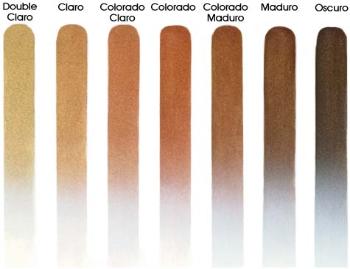
Wrapper color chart
Cigar size & shape
Most cigars come in boxes with a front mark that tells you the
shape of the cigar, such as Punch Double Corona or Partagas
8-9-8. As you come to know shapes, you also can make some
assumptions about size, such as knowing that a double corona
is not a short cigar. Cigar Size. The basic measurement
standard, however, is the same; the only variations are whether
it is expressed in metric or U.S. Customary systems. Length,
therefore, is listed in inches or is commonly known, is in 64ths
of an inch or millimeters. So, a classic corona size is 6 by 42,
which means it is six inches long and 42/64ths of an inch thick,
but many manufacturers today produce their coronas with a 44
ring gauge, as opposed to a 42. Simply put, ring size is
measured in 64ths of an inch. Thus, a 48 ring cigar will
measure 3/4 inch in diameter. Cigar Shapes. If you're
searching for common denominators to use as a starting point
for shape, it helps to know that all cigars can be divided into two
categories: parejos, or straight sides, and figurados, the
irregular shapes. Simply, parejos are straight-sided cigars, the
kind with which most smokers are familiar. There are three
basic groups in this category: coronas, panetelas and
lonsdales.
A corona (the classic size is 6 inches by 42 ring gauge) has
traditionally been the manufacturers' benchmark against which
all other cigars are measured. Coronas have an open "foot"
(the end you light) and a closed "head" (the end you smoke);
the head is most often rounded. A Churchill measures 7 inches
by 47 ring gauge. A robusto is 5 inches by 50 ring gauge. A
double corona is 7 1/2 inches by 49 ring gauge. Panetelas (a
standard size is usually 7 inches by 38 ring gauge) are usually
longer than coronas, but they are dramatically thinner. They
also have an open foot and closed head. Lonsdales (6 3/4
inches by 42 and longer than coronas. The irregular shapes, or
figurados, encompass every out-of-the ordinary shaped cigar.
The following list comprises the major types:
Pyramid - It has a pointed, closed head and widens to an open
foot.
Belicoso - A small pyramid-shaped cigar with a rounded head
rather than a point.
Torpedo - A shape with a pointed head, a closed foot and a
bulge in the middle.
Perfecto - These look like the cigar in cartoons with two closed
rounded ends and a bulge in the middle.
Culebras - Three panetelas braided together.
Diademas - A giant cigar 8 inches or longer. Most often it has
an open foot, but occasionally it will come with a perfecto tip, or
closed foot.
Remember, even with these "classic" irregular shapes, there
are variations among manufacturers. Some cigars called
belicosos look like pyramids, and some called torpedos look
like pyramids because they do not have a perfecto tip
shape of the cigar, such as Punch Double Corona or Partagas
8-9-8. As you come to know shapes, you also can make some
assumptions about size, such as knowing that a double corona
is not a short cigar. Cigar Size. The basic measurement
standard, however, is the same; the only variations are whether
it is expressed in metric or U.S. Customary systems. Length,
therefore, is listed in inches or is commonly known, is in 64ths
of an inch or millimeters. So, a classic corona size is 6 by 42,
which means it is six inches long and 42/64ths of an inch thick,
but many manufacturers today produce their coronas with a 44
ring gauge, as opposed to a 42. Simply put, ring size is
measured in 64ths of an inch. Thus, a 48 ring cigar will
measure 3/4 inch in diameter. Cigar Shapes. If you're
searching for common denominators to use as a starting point
for shape, it helps to know that all cigars can be divided into two
categories: parejos, or straight sides, and figurados, the
irregular shapes. Simply, parejos are straight-sided cigars, the
kind with which most smokers are familiar. There are three
basic groups in this category: coronas, panetelas and
lonsdales.
A corona (the classic size is 6 inches by 42 ring gauge) has
traditionally been the manufacturers' benchmark against which
all other cigars are measured. Coronas have an open "foot"
(the end you light) and a closed "head" (the end you smoke);
the head is most often rounded. A Churchill measures 7 inches
by 47 ring gauge. A robusto is 5 inches by 50 ring gauge. A
double corona is 7 1/2 inches by 49 ring gauge. Panetelas (a
standard size is usually 7 inches by 38 ring gauge) are usually
longer than coronas, but they are dramatically thinner. They
also have an open foot and closed head. Lonsdales (6 3/4
inches by 42 and longer than coronas. The irregular shapes, or
figurados, encompass every out-of-the ordinary shaped cigar.
The following list comprises the major types:
Pyramid - It has a pointed, closed head and widens to an open
foot.
Belicoso - A small pyramid-shaped cigar with a rounded head
rather than a point.
Torpedo - A shape with a pointed head, a closed foot and a
bulge in the middle.
Perfecto - These look like the cigar in cartoons with two closed
rounded ends and a bulge in the middle.
Culebras - Three panetelas braided together.
Diademas - A giant cigar 8 inches or longer. Most often it has
an open foot, but occasionally it will come with a perfecto tip, or
closed foot.
Remember, even with these "classic" irregular shapes, there
are variations among manufacturers. Some cigars called
belicosos look like pyramids, and some called torpedos look
like pyramids because they do not have a perfecto tip
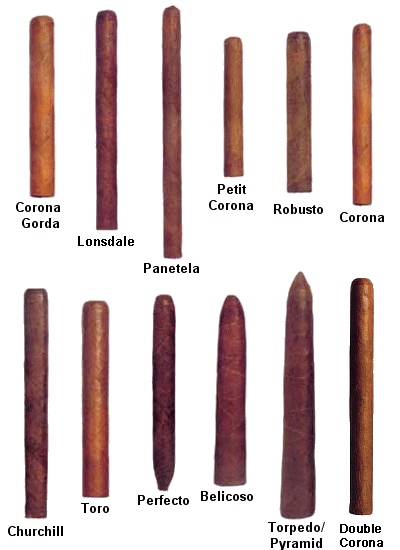

| TopQualityCigars.com |
| Feel Free To Call Us 1.630.834.7777 |
Copyright © 2012 Top Quality Cigars. All rights reserved.

All items, including style, color Selection,
prices are subject to availability and can
change without notice. Typographic and/or
photographic errors are subject to
correction. Please email us for any
suggestions. Thank You
prices are subject to availability and can
change without notice. Typographic and/or
photographic errors are subject to
correction. Please email us for any
suggestions. Thank You
topqualitycigars.com site does not sell cigars or any related products to anyone under the age of 18 (or the minimum age in your local jurisdiction,
whichever is higher). We do not sell cigarettes. We operate our site in compliance with the children's online privacy protection act. And will not
knowingly collect or use any personal information from anyone under the legal age limit. Thank You
whichever is higher). We do not sell cigarettes. We operate our site in compliance with the children's online privacy protection act. And will not
knowingly collect or use any personal information from anyone under the legal age limit. Thank You
|
|
|
|
|
|
|
|

|
|
|
|
|
|


| Visitor's Traffic Every visitor leaves an eternal dot and current visitor leaves an active dot on the globe. |

